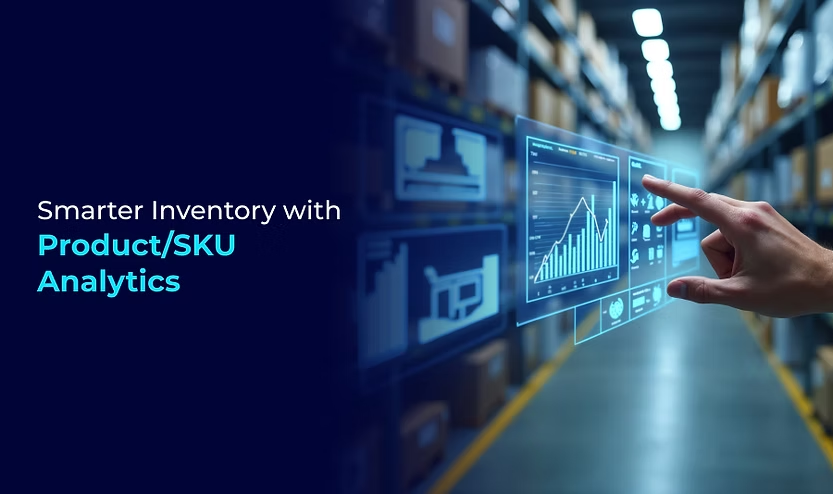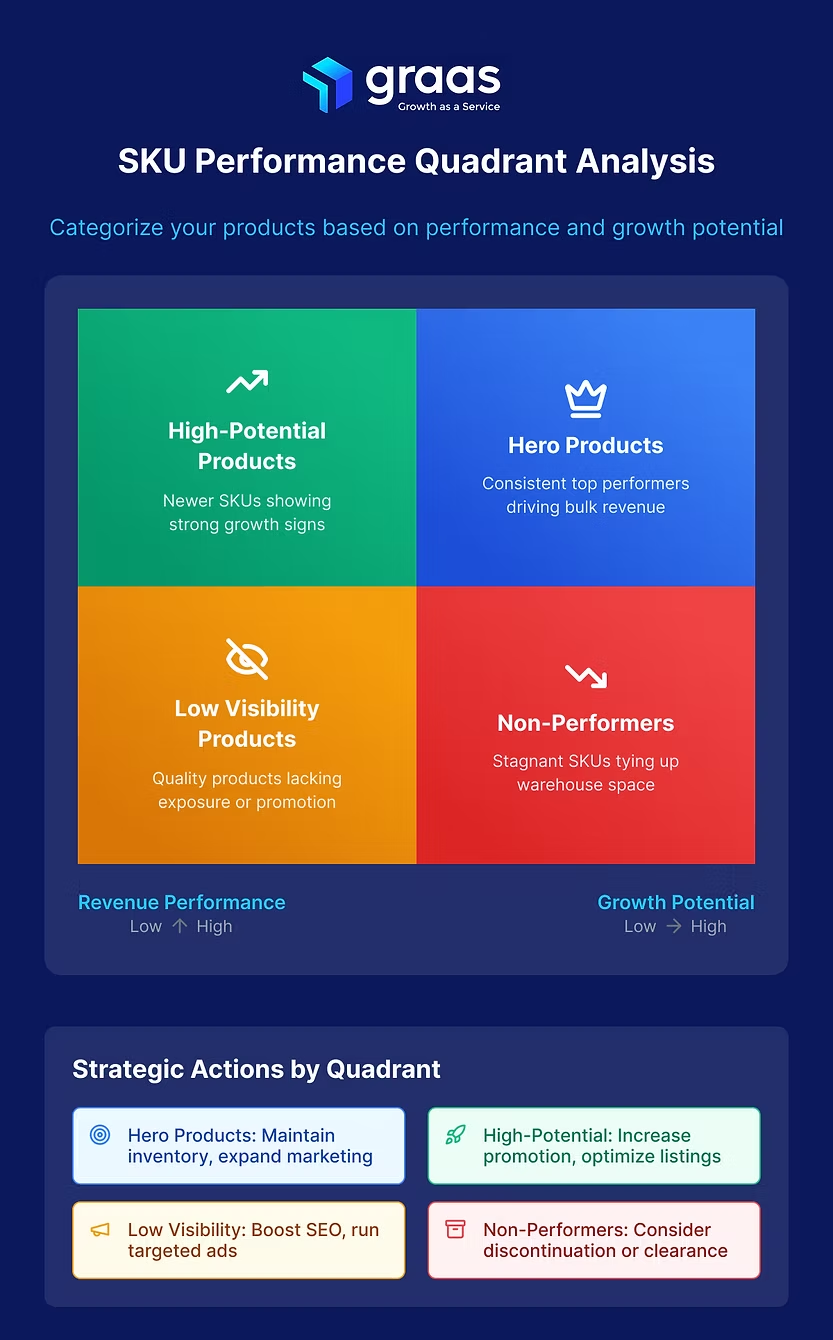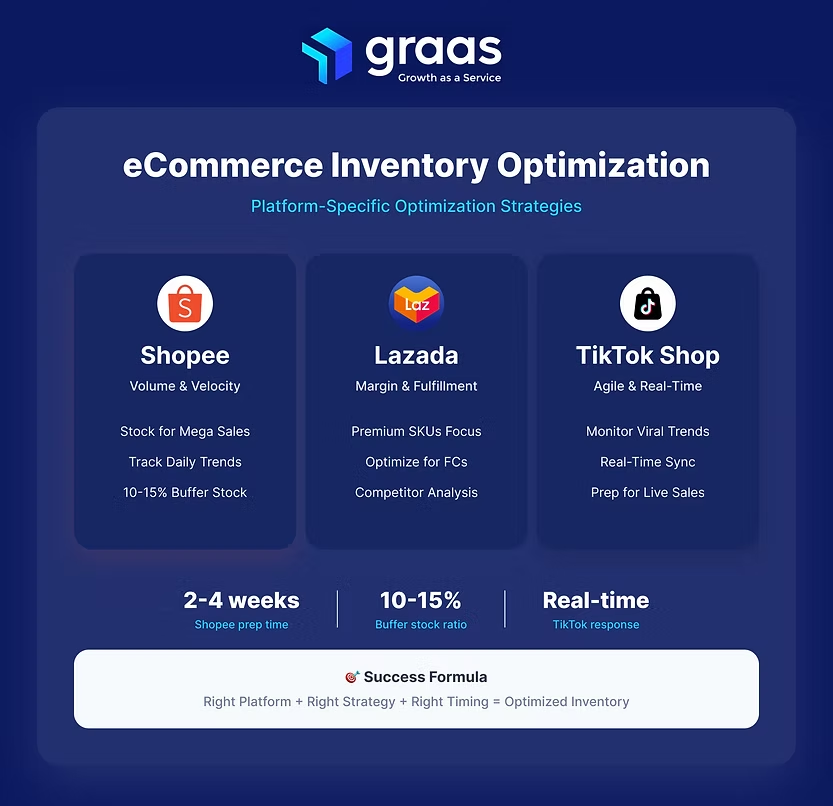
The Southeast Asian eCommerce industry moves faster than its counterparts. This makes managing inventory efficiently across platforms like Shopee, Lazada, and TikTok Shop critical.
With SKU data, sellers can monitor real-time stock levels, identify top sellers, and prevent overstocking or stockouts across marketplaces. Platforms such as Shopee and Lazada offer native analytics, while TikTok Shop equips merchants with live performance dashboards that enable data-driven decisions.
However, the native dashboards rarely provide the complete picture. And it becomes even more challenging when comparing the performance of the business across different platforms.
Effective SKU analytics allows timely restocking, promotion planning, and cross-platform synchronization, avoiding errors during peak campaigns like 11.11.
In this blog, we'll tap into analytics & insights, interpret SKU performance, and forecasting strategies to maintain balanced inventory and maximise sales across Shopee, Lazada, and TikTok Shop.
Managing inventory across these platforms requires understanding the dynamics of each platform. What works for one channel might completely backfire on another. Below are key marketplace-specific challenges that sellers must navigate.
Shopee thrives on aggressive pricing, fast-moving products, and limited-time campaigns. Flash sales, bundling strategies, and free shipping promos drive massive traffic, but they can also strain inventory if not tracked in real time.
An SKU can go from underperforming to overselling within a single campaign. Sellers must constantly adjust stock levels and monitor sell-through rates to avoid stockouts or cancellations.
Unlike Shopee, Lazada emphasizes a more premium shopping experience. It relies heavily on voucher-based promotions, warehouse optimization, and higher-value products.
This often leads to inventory stratification, where sellers must reserve premium stock for Lazada while ensuring it's not cannibalizing sales on Shopee or TikTok.
Misallocating high-demand products can result in unsold inventory on slower platforms and missed revenue on faster ones.
TikTok Shop presents perhaps the most volatile challenge: viral-driven demand. A single influencer or trending sound can cause a product to sell out overnight.
However, these viral spikes are hard to predict and even harder to fulfill. Nearly 70% of sellers report experiencing stockouts or shipping delays due to unanticipated demand surges.
Without a real-time analytics and replenishment strategy, sellers risk losing customer trust and long-term brand value.
Effective inventory management starts with granular product visibility, and SKU-level analytics is the backbone of this insight. Understanding performance at product level, sellers can make more informed, data-driven decisions across all eCommerce platforms.
Not all products are created equal. SKU analytics allows sellers to categorize products into key performance buckets:

This classification helps prioritize promotional spend, delisting decisions, and inventory clearance campaigns, improving efficiency and profit margins.
Using historical sales data, seasonal trends, and campaign performance, SKU analytics helps forecast demand with greater accuracy. Rather than guessing how many units to order or where to place them, sellers use data to:
Forecasting reduces last-minute panic buying and warehouse overflow while improving customer satisfaction.
Each marketplace is different, and SKU analytics helps allocate inventory accordingly.
Real-time analytics ensures you’re not just moving stock, but moving it smartly, improving sell-through rates, reducing returns, and maximizing ROI across all channels.
Each marketplace has its own algorithms, buyer behavior patterns, promotional structures, and logistics ecosystems.
To maximize sell-through and minimize losses, sellers must tailor strategies to match each platform’s unique commercial DNA. Below, we break down proven strategies for each and explain how to put them into practice.

Shopee’s buyer base is highly price-sensitive, promotion-driven, and reactive to real-time sales events. Products on Shopee often experience extreme fluctuations in velocity, especially during Mega Campaigns (9.9, 11.11, 12.12) or Flash Sales, where deals can sell out in minutes. Sellers who succeed here anticipate demand surges and maintain operational agility.
Lazada caters to a slightly more premium demographic, with a focus on branded experiences, value-added services, and fast delivery. Unlike Shopee’s volume-driven model, success here depends on curating the right inventory mix and optimizing fulfillment through Lazada’s warehouses (Fulfilled by Lazada – FBL).
TikTok Shop’s algorithm introduces a new layer of complexity, as product demand here is driven less by long-term strategy and more by short-lived virality. Sellers must be ready to ride trends and react to spikes within hours. It’s not about forecasting quarterly demand, it's about reacting instantly to what’s viral today.
Product/SKU analytics provides the data clarity needed to take the guesswork out of your inventory strategy and replace it with precision.
Here's how it transforms decision-making:
By analyzing historical sales patterns, campaign performance, and seasonal trends, SKU analytics allows you to accurately forecast future demand. This reduces the risk of overstocking, which ties up capital and warehouse space, which result in lost sales and poor customer experience. Predictive models help you order just the right amount.
Not all SKUs contribute equally to your revenue. Some drive traffic, some improve margins, and others simply take up shelf space. SKU analytics lets you track the performance of each product across platforms to identify:
This helps you fine-tune your product assortment strategy to maximize ROI and reduce inventory deadweight.
Marketplace behavior shifts rapidly. With real-time insights, SKU analytics allows you to reallocate stock dynamically, like moving more units to Shopee during flash sales or reserving viral products for TikTok Shop. This responsive approach ensures your inventory is always aligned with where the demand is strongest.
Want to take better control of your inventory?
Use Graas Product/SKU Analytics to forecast demand, track performance, and dynamically manage stock across Shopee, Lazada, and TikTok Shop.
The Southeast Asian eCommerce industry moves faster than its counterparts. This makes managing inventory efficiently across platforms like Shopee, Lazada, and TikTok Shop critical.
With SKU data, sellers can monitor real-time stock levels, identify top sellers, and prevent overstocking or stockouts across marketplaces. Platforms such as Shopee and Lazada offer native analytics, while TikTok Shop equips merchants with live performance dashboards that enable data-driven decisions.
However, the native dashboards rarely provide the complete picture. And it becomes even more challenging when comparing the performance of the business across different platforms.
Effective SKU analytics allows timely restocking, promotion planning, and cross-platform synchronization, avoiding errors during peak campaigns like 11.11.
In this blog, we'll tap into analytics & insights, interpret SKU performance, and forecasting strategies to maintain balanced inventory and maximise sales across Shopee, Lazada, and TikTok Shop.
Managing inventory across these platforms requires understanding the dynamics of each platform. What works for one channel might completely backfire on another. Below are key marketplace-specific challenges that sellers must navigate.
Shopee thrives on aggressive pricing, fast-moving products, and limited-time campaigns. Flash sales, bundling strategies, and free shipping promos drive massive traffic, but they can also strain inventory if not tracked in real time.
An SKU can go from underperforming to overselling within a single campaign. Sellers must constantly adjust stock levels and monitor sell-through rates to avoid stockouts or cancellations.
Unlike Shopee, Lazada emphasizes a more premium shopping experience. It relies heavily on voucher-based promotions, warehouse optimization, and higher-value products.
This often leads to inventory stratification, where sellers must reserve premium stock for Lazada while ensuring it's not cannibalizing sales on Shopee or TikTok.
Misallocating high-demand products can result in unsold inventory on slower platforms and missed revenue on faster ones.
TikTok Shop presents perhaps the most volatile challenge: viral-driven demand. A single influencer or trending sound can cause a product to sell out overnight.
However, these viral spikes are hard to predict and even harder to fulfill. Nearly 70% of sellers report experiencing stockouts or shipping delays due to unanticipated demand surges.
Without a real-time analytics and replenishment strategy, sellers risk losing customer trust and long-term brand value.
Effective inventory management starts with granular product visibility, and SKU-level analytics is the backbone of this insight. Understanding performance at product level, sellers can make more informed, data-driven decisions across all eCommerce platforms.
Not all products are created equal. SKU analytics allows sellers to categorize products into key performance buckets:

This classification helps prioritize promotional spend, delisting decisions, and inventory clearance campaigns, improving efficiency and profit margins.
Using historical sales data, seasonal trends, and campaign performance, SKU analytics helps forecast demand with greater accuracy. Rather than guessing how many units to order or where to place them, sellers use data to:
Forecasting reduces last-minute panic buying and warehouse overflow while improving customer satisfaction.
Each marketplace is different, and SKU analytics helps allocate inventory accordingly.
Real-time analytics ensures you’re not just moving stock, but moving it smartly, improving sell-through rates, reducing returns, and maximizing ROI across all channels.
Each marketplace has its own algorithms, buyer behavior patterns, promotional structures, and logistics ecosystems.
To maximize sell-through and minimize losses, sellers must tailor strategies to match each platform’s unique commercial DNA. Below, we break down proven strategies for each and explain how to put them into practice.

Shopee’s buyer base is highly price-sensitive, promotion-driven, and reactive to real-time sales events. Products on Shopee often experience extreme fluctuations in velocity, especially during Mega Campaigns (9.9, 11.11, 12.12) or Flash Sales, where deals can sell out in minutes. Sellers who succeed here anticipate demand surges and maintain operational agility.
Lazada caters to a slightly more premium demographic, with a focus on branded experiences, value-added services, and fast delivery. Unlike Shopee’s volume-driven model, success here depends on curating the right inventory mix and optimizing fulfillment through Lazada’s warehouses (Fulfilled by Lazada – FBL).
TikTok Shop’s algorithm introduces a new layer of complexity, as product demand here is driven less by long-term strategy and more by short-lived virality. Sellers must be ready to ride trends and react to spikes within hours. It’s not about forecasting quarterly demand, it's about reacting instantly to what’s viral today.
Product/SKU analytics provides the data clarity needed to take the guesswork out of your inventory strategy and replace it with precision.
Here's how it transforms decision-making:
By analyzing historical sales patterns, campaign performance, and seasonal trends, SKU analytics allows you to accurately forecast future demand. This reduces the risk of overstocking, which ties up capital and warehouse space, which result in lost sales and poor customer experience. Predictive models help you order just the right amount.
Not all SKUs contribute equally to your revenue. Some drive traffic, some improve margins, and others simply take up shelf space. SKU analytics lets you track the performance of each product across platforms to identify:
This helps you fine-tune your product assortment strategy to maximize ROI and reduce inventory deadweight.
Marketplace behavior shifts rapidly. With real-time insights, SKU analytics allows you to reallocate stock dynamically, like moving more units to Shopee during flash sales or reserving viral products for TikTok Shop. This responsive approach ensures your inventory is always aligned with where the demand is strongest.
Want to take better control of your inventory?
Use Graas Product/SKU Analytics to forecast demand, track performance, and dynamically manage stock across Shopee, Lazada, and TikTok Shop.